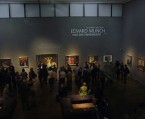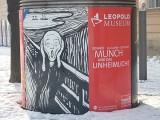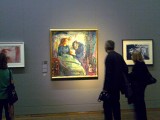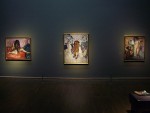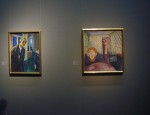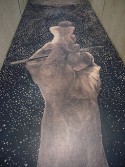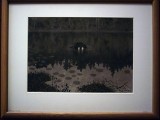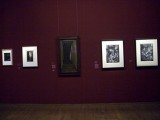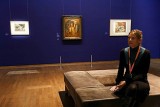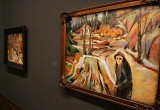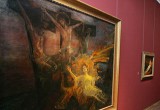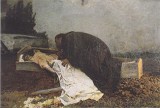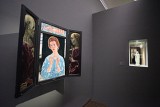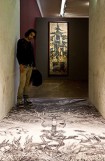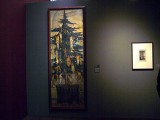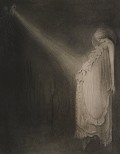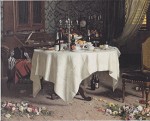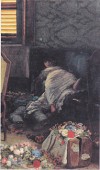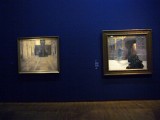The browser will either open the file, download it, or display a dialog.
Edvard Munch und das Unheimliche (Edvard Munch and the Uncanny)
Leopold Museum, Vienna
16 October 2009 – 18 January 2010
Catalogue:
Edvard Munch und das Unheimliche
Edited by Michael Fuhr and Rudolf Leopold.
Vienna: Christian Brandstätter Verlag, 2009.
304 pp; 243 color illustrations; eight essays (by Fuhr and other scholars) and artist biographies, all with English translations; selected bibliography
€39.90
ISBN: 978-3-85033-365-8
Vienna, the city of Sigmund Freud, and Edvard Munch, the master of visual self- analysis, were paired in a recent exhibition at the Leopold Museum, renowned for its holdings of the equally psychologically absorbed artists Alfred Kubin, Egon Schiele, and Oscar Kokoschka. Munch was featured in a vast show that included forty-two European artists and over two hundred works organized around the theme of the uncanny, the subject of an essay published by Freud in 1919. Freud considered his project an "aesthetic investigation" into feelings of "repulsion and distress," but one limited to literature.[1] So too the profusion of writings on the topic have been authored mostly by literary historians, especially those oriented towards psychoanalysis and the work of Jacques Lacan. With the exception of the recent anthology, Orte des Unheimlichen (Sites of the Uncanny), the visual arts have been less frequently considered, and those studies have been largely restricted to the twentieth century.[2] The Leopold Museum, therefore, was pioneering in its organization of an exhibition of nineteenth-century art that explored a concept famously associated with the unseen and the inexplicable.
This show was not, however, the first time that Munch's art had been exhibited in Vienna and admired for its eerie effects. Twenty of his paintings were originally on view at the Vienna Secession in 1904, when the critic Ludwig Hevesi praised them for bringing to light the "inward projection of the enigmatic" and the "world beyond sensate experience," and for sounding a "chord" that was "uncannily lacking in solace."[3] These associations were foregrounded in the Leopold Museum's exhibition, whose purpose was, according to the curator Michael Fuhr in his catalogue text, to examine the uncanny in the art that preceded the publication of Freud's essay (272). In effect, the exhibition presented visual expressions of the tradition upon which Freud drew, complimenting the literary sources, such as E.T.A. Hoffmann's short story "The Sandman," cited in his writing. Freudian concepts were therefore referenced in several wall texts and throughout the catalogue.
Manifestations of this earlier tradition intensified in the later nineteenth century, and one of the intentions of the exhibition, which was successfully realized, was to document the uncanny as the product of resistance to a positivist industrialized society. Most of the multimedia work (paintings, prints, drawings, and a few sculptures) dated from the late nineteenth and early twentieth centuries, with occasional inclusions from the eighteenth century (Henry Fuseli, Giovanni Battista Piranesi, and Francisco Goya), the era considered to be the birthplace of the uncanny.[4] Munch was chosen as an artist "at the end of the time span covered" who provided a capstone and reinterpretation of prevailing themes (272). Judging from the crowds who flocked to the museum, the number of posters of The Scream that dotted the city, and the amount of online response, the exhibition was a popular success (figs. 1 and 2). Opening as it did in time for Halloween, and capitalizing on the recent fascination with vampires, it also benefited from coordinated literary events, such as readings from stories by Edgar Allen Poe and E.T.A. Hoffmann at a local theater.
Munch may have been at the chronological endpoint of the show, but his art in the first two rooms served as the viewers' introduction to the following seven sections which were organized thematically. This strategy had advantages and disadvantages. Munch's blazing colors and formal innovations, seen in thirty-seven paintings and prints, many loaned by the Munch Museum in Oslo, tended to overshadow much of the subsequent art which often appeared somber and conventionally representational by comparison. Little attempt was made in the wall texts to chart paths of intersecting contact between Munch and other artists, although that material has been thoroughly examined in Jay Clarke's exhibition and catalogue, Becoming Edvard Munch: Influence, Anxiety, and Myth, at the Art Institute of Chicago in 2009. Munch's images, nonetheless, effectively provided a guide for themes to come: reality transformed and destabilized by recollected trauma and anxiety. As with the ensuing pictures in the exhibition, and the subjects of Freud's essay, Munch's art deals with death, mothers, children, loss, nocturnal fears, and sexuality. His works in the first room were grouped along roughly similar lines, displaying scenes of sex and death (Kiss, Madonna, Vampire II, and Sin, among others) and illness and childhood as well as paintings from the Frieze of Life series (fig. 3). The second room featured images, many from later in his career, of murder (The Murderess and Murder on the Road) and intense or trancelike emotional states (Weeping Nude, Desire, Death and the Woman, and Moonlight.) Taken in conjunction with the painting Galloping Horse, which dominated the space and could be seen through the doorway of the first room, the art suggested atavistic forces and, according to Fuhr's essay, the untamable "elementary power of nature." (278; fig. 4).
Among the most striking effects of the Munch rooms were the repeated gazes of the artist (and other sitters) peering out at the viewer, their expressions a portrait of the fear, apprehension, and introspection that characterize an uncanny moment. Memories of The Night Wanderer, Jealousy,Jealousy II, and Moonlight, Night in St. Cloud, aligned on a wall at the entrance to the exhibition, remained with the viewer throughout the show (fig. 5). They underscored the performative nature of an aesthetic concept manifested through experience rather than material objects. As stated in the wall text of the first room (all information labels were helpfully translated into English): "What they [the art] share in common is the depiction of something that does not really exist. No picture is per se uncanny; uncanniness arises only in the sensation of the viewer." The exhibition spaces, which were below ground level with walls painted charcoal gray, dark blue, and deep red, successfully created a tenebrous environment conducive to that mood. It was further enhanced by musical selections in each room, available through the audio guide, that were linked thematically to the art. The second room, for example, featured Nordic folk tunes by Grieg. These inclusions underscored traditional associations between the uncanny, music, and literature. Not surprisingly, much of the exhibited art was the result of literary inspiration or illustration, with a vast array of authors cited, ranging from Poe, Hoffmann, Victor Hugo, and John Milton to Gustave Flaubert, Arthur Rimbaud, Jules Barbey d'Aurevilly, and Georges Rodenbach.
One of the more interesting design features of the show were passageway floors between rooms on which appeared reproductions of exhibited works. Visitors walked over Klemens Brosch's First Draft of the Artist's Ex libris, for example, to enter the third room, "Symbols of the Unconscious" (fig. 6). Here, James Ensor was the featured artist, represented by seventeen prints and paintings, three of which had been hung in the previous room. His imagery of masks was combined with two other symbols: stairways, whose origins were traced to Piranesi, and bodies of water. All were meant to evoke the "concealed worlds" (wall text) beyond the visible and rational. Conceptually, this room, like the previous two, was best understood as a further introduction to the uncanny, since the theme of the gallery referred to the technique of symbolization operative throughout most of the exhibition. Otherwise, one might well ask why Theodor Kittelsen's Water Sprite, was included here rather than in a later room devoted to nature spirits (fig. 7). Indeed, this room highlighted some of the organizational strengths and weaknesses of the show. It was most effective, at least to this viewer, when the thematic focus was the most specific. The depictions of staircases by Alfred Kubin, Eugène Laermans, Piranesi and Kittelsen were fascinating to compare, and demonstrated a unifying sensibility of ominous mystery across disparate styles (fig. 8). This taut focus on three symbolic objects, however, was not consistently followed. Figural representations of the unconscious (Franz Von Stuck's painting Male Portrait Study/A Bad Conscience and Brosch's drawing) added a somewhat discordant note to the room.
Broader topics, such as those of the fourth and fifth rooms ("Dreams and Nightmares" and "Spirits of the Night"), included works which were at times interchangeable. Selections according to categories seemed somewhat arbitrary (Max Klinger's print series The Glove, for example, could have been introduced here), and many images, in fact, were reproduced elsewhere in the catalogue, which followed the same thematic structure as the exhibition. To cite one example, Francois-Nicolas Chifflart's The Conscience and three prints by Kubin of aquatic subjects were hung in the "Dreams and Nightmare" room, but appeared as illustrations of "Symbols of the Unconscious" in the book. No explanation or rationale was presented for these discrepancies.
"Dreams and Nightmares," accompanied by music from the fourth movement of Hector Berlioz's Symphonie Fantastique, featured six prints by Goya, the influential master of this genre, and many by Kubin. It was less clear why Gustave Moreau's Victim appeared between Fuseli drawings (fig. 9). Honoré Daumier's lithograph, Horsemeat is a Healthy and Easily Digestible Food, aptly satirized visualizations of the nightmare represented by Fuseli, but the comic tone seemed out of place in conjunction with the prevailing mood of anxious unease. Daumier's other print, A Strike of Phantasy, had only tangential connections to the room's theme of nocturnal terrors.
The next room, "Spirits of the Night," entered via the footpath of Kittelsen's Forest Troll, displayed the most disparate assemblage of art, encompassing the late German Romantic painting Church Ruin in the Snow by Carl Georg Adolf Hasenpflug, Gustav Klimt's portrait sketch of a female head symbolizing Erinye, Félicien Rops' drawing Transformism I, and two zincographs by Paul Gauguin from his Volpini Suite. In order to make sense of this assortment, the viewer needed to consult the wall text, which identified the unifying topic as the re-enchantment of nature in an age of positivism and Darwin. Inspired by legends, fairy tales and ghost stories, artists depicted witches, trolls, gnomes, and mythological figures. Works that best exemplified this disturbingly animated view of nature included the Kittelsen Forest Troll, Arnold Böcklin's Will-o-the-Wisp, Karl Diefenbach's Sea Ghost, Kubin's water monsters, and Aksei Waldemar Johannessen's Break of Spring (fig. 10). This room also included ceramic heads by Dina Kuhn (Head)and Bertold Löfflel (Forest Sprite Vase) that personified elemental forces.
The thematic organization was intended to highlight artistic individuality and "uniqueness," according to Fuhr, and demonstrate "how they [artists] integrate their own thoughts, interpretations and stylistic devices." (274). Nowhere did this lead to greater formal and, one is tempted to say, qualitative diversity than in the room dedicated to "Visions of the Occult." Listening to the music of Edward Elgar (Sighs, Op. 7), the viewer moved among six prints and drawings by Odilon Redon, four of Alberto Martini's Rimbaud-inspired lithographs from the series Mysteries, and paintings of mystics and mediums by Albert von Keller and Gabriel von Max. Martini's proto-Surrealist prints of horrific figural deformities were characterized by glossy surfaces and Futurist shard-like forms that contrasted starkly with Redon's velvety hazy noirs. While only one of those (from the Temptation of St. Anthony cycle) fully conformed to the occult theme, the works by von Keller and von Max were the centerpiece of the room (fig. 11). These artists were members of the Munich "Psychological Society" formed around the physician/hypnotist Albert von Schrenck-Notzing and the philosopher Carl du Prel. This information was provided in the wall text, together with a brief history of parapsychology, and discussed in greater detail in the catalogue essay by Nico Kirchberger. For a German audience, the heritage of nineteenth-century interest in the paranormal, given epistemological respectability by Schopenhauer's 1851 "Essay on Spirit Seeing," was a critical antecedent to Freud's exploration of the uncanny.
Freud was first mentioned in the wall text of the seventh room, whose focus was "Death and the Devil." As stated in the label, Freud considered "death, dead bodies, revenants, spirits and ghosts" to be "the acme of the uncanny," and the most representative of primitive fears unchanged in modern man.[5] The curatorial decision to present most of the art without citing Freud's writing was certainly justified on the basis of chronology and a desire to allow for an undirected viewer response. However, to anyone familiar with the essay, Freud's unnamed presence hovered over the exhibition, and earlier references to his essay would have been useful in providing a unifying structure and theoretical justification for the thematic categories. The introductory texts in the catalogue, which are slightly lengthier versions than those on the wall, discuss Freud more frequently and his ideas are central to most of the guest-authored essays.
According to the wall text in this gallery, the artworks here were chosen because they represented themes of mortality in the uncanny as well as the related topic of eroticism. When Freud conceived of the essay, he was formulating not only the "death drive," but also the "pleasure principle." Accordingly, images of the femme fatale and the sphinx, mostly by Rops, were included in this room, while the subject of a lover's revenge taken from an 1877 novel, Song of Hate, by Olindo Guerrini, was depicted in the macabre painting Hatred by the Italian artist Pietro Pajetta. (fig. 12). Among the most poignant scenes were those that juxtaposed death with contemporary life, such as Klinger's etching Death of a Child (On Death I) and Cuno Amiet's stylized triptych Hope – Transitoriness, portraying the artist's wife and infant daughter, who died in childbirth (fig. 13). These images also provided a connection to the next room, which was focused on the home. At the end of the room were hung five stylistically diverse prints and drawings of the plague by Klinger, Kubin, Kittelsen, Ensor, and the illustrator Jacque Ernst Sonderegger. They presented fantastic variations on real life fears, a combination (imagination and "the ground of common reality") that Freud considered essential to the uncanny.[6] This room, with its blending of skeletons, satanic figures, female temptresses, and personal tragedy, most successfully established a context to which Munch could be related. Musical selections included Camille Saint-Saëns' Danse Macabre and Modest Mussorgsky's "Catacombs" from Pictures at an Exhibition.
Turning away from the plague scenes, the viewer walked over an image of Rop's The Scraps to confront one of the most arresting corners in the exhibition (fig. 14). Arnoldo Bonzagni's The Hanging Tree, a bizarre Christmas tree decorated with dead Turks as ornaments and probably the most shocking image of the show, was intended as an anti-war protest against Italian imperialist policies in the 1911 Italo-Turkish War. It was displayed next to Kubin's Madame (Modern Chandeleier Decoration) (fig. 15) and adjacent to the wall on which hung Kubin's The Blessed (fig. 16), and two illustrations for d'Aurevilly's Les Diaboliques (Kubin's After the Abortion, and Rops' The Underside of the Cards at a Game of Whist). From the perspective of the uncanny, Bonzagni's Tree functioned, together with Kubin's images of a chandelier corpse in an elegant room, a dead baby, and a pregnant woman in the grip of demonic possession, as a profoundly disturbing destabilization of the seemingly safe world of family and home. The theme of this section of the exhibition, "Das unheimliche Heim" ("The Uncanny Home"), referred to the etymological root of the word in German, which was central to Freud's conception of the phenomenon. Over time, "heimlich" developed a meaning that merged with its antonym "unheimlich," thus conveying not only the homey and familiar, but also the secretive and concealed. For Freud, this indicated repressed childhood memories as the source of the uncanny, which undermined reassuring notions of identity and place. As discussed in the catalogue essay "Edvard Munch and the Hidden Depths of Memory" by Mai Britt Guleng, Munch exemplified this experience. He "linked disturbing and anxiety-filled themes to his personal experiences and memories from childhood and adulthood." His art "makes us feel like strangers in our own home" (277).
This room, which included von Stuck's eerie ceremonial party, Dinner (1913) and Mihály von Munkácsy's The Last Day of a Condemned Man (c.1869), featured two complete cycles of twenty etchings by Max Klinger, The Glove (1881) and A Love (1887). As the wall text noted, Klinger excelled in discovering the unnerving and traumatic qualities within everyday life and the individual psyche, as had his literary inspiration E.T.A. Hoffmann, who was praised by Freud as the "unrivalled master of the uncanny in literature."[7] Klinger was nearly upstaged, however, by Angelo Morbelli's riveting large paintings, Asphyxia I and II, depicting a lavish dining room in sumptuous detail (fig. 17). In keeping with the dualism of "das Unheimlich," a mood of strangeness and decay prevails, leading to the revelation of the interior's dark secret, the bodies of a couple partially concealed in the shadows of the smaller painting (fig. 18). Originally one canvas, the work was subsequently divided by the artist into two parts, severing the death tableau after receiving bad reviews in 1884. Across from these pictures hung two paintings by the Belgian artist Léon Spillaert, Still Life and Second of November. In stylistic contrast to the hothouse profusion of Morbelli's realism, these close-up views disclosed empty spaces constructed out of loosely brushed planes of nearly monochromatic color. They conveyed even more effectively, though, a mood of haunting enigma and unspecified danger. Taken together, the four paintings exemplified the curatorial mission of exhibiting diverse, but equally successful, artistic strategies for evoking the uncanny.
The transition from domestic interiors to the urban spaces of "The Dead City" in the final room highlighted the crucial role of architectural settings in the development of the uncanny during the nineteenth century. As has been discussed by Anthony Vidler and others, the literary uncanny was first staged in the privacy of the interior, but after mid-century was increasingly to be found in big cities, a phenomenon observed by Walter Benjamin in his writings on Charles Baudelaire.[8] As evidenced by the images in this room, the metropolitan uncanny became associated with psychological illness, degeneration, and social conflict. Here, a somber mood of hushed stillness exuded from art exhibited on dark blue walls. The central focus was the city of Bruges, with Georges Rodenbach's book, Bruges-La-Morte, displayed together with Fernand Knopff's study for the cover, Georg Minne's plaster personification of the city, and a copy of Siegfried Trebitsch's theatrical adaptation of the novel, The Silent City. The twilight netherworld of unpopulated back streets and squares was most effectively evoked in the prints and drawings by Jules de Brucyker and a trio of images of Bruges and Paris: Georges de Feure's The Transfer, Khnopff's In Bruges, A Church, and Frantz Charlet's The Golden Houses of Bruges (fig. 19). Here, muffled forms pursuing mysterious self-absorbed activities inhabit a borderland of shadowy spaces that are psychological as well as physical. Other pictures included scenes of Paris by Charles Méryon (the etchings The Pont-au-Change, The Pump, Notre Dame, The Mortuary, and The Vampyr); of Berlin by Klinger (the etching A Mother II, from the cycle Dramas); of Krumau an der Moldau by Schiele (the painting Dead City III); and of imaginary towns by Kubin (the drawing Downfall and lithograph Death in the City). As a whole, these artworks with their imagery of water, architecture, and stairways, echoed those in the earlier "Symbols of the Unconscious" section, and provided a unified conclusion to the exhibition.
"Edvard Munch und das Unheimliche" offered further evidence that, on the cusp of modernism, artists and their audiences were fascinated with a liminal world that was irrational, unpredictable, and related to the growing bourgeois passion for privacy, the topic of a recent show at the National Gallery of Art in Washington D.C.. As demonstrated at the Leopold Museum, this interest was extremely widespread, and the curator is to be congratulated for assembling a remarkable number of previously little-known artists who have now been integrated into this particular art historical narrative. For those who missed the exhibition, the catalogue reproduces nearly all the works and includes brief biographies for each artist, together with seven essays by scholars in art history and psychology on topics related to Munch, Klinger, Ensor, and themes of the supernatural and twilight.
Marsha Morton
Pratt Institute
mortonmarsha10[at]gmail.com
[1] Sigmund Freud, "The Uncanny," in Freud, The Uncanny, translated by David McClintock (London and New York: Penguin Books, 2003), 123.
[2] Klaus Herding and Gerlinde Gehrig, eds., Orte des Unheimlichen: Die Faszination verborgenen Grauens in Literatur und bildender Kunst (Göttingen: Vandenhoeck & Ruprecht, 2006). This book includes essays on writers and artists such as René Magritte, Théodore Géricault, Charles Méryon, J.A.D. Ingres, and Edward Hopper. Most literature on the arts and the uncanny has been concerned with Surrealism, as in Hal Foster's exemplary text, Compulsive Beauty (Cambridge, MA: The MIT Press, 1993).
[3] Ludwig Hevesi, "Weiteres aus der Sezession." (4 Februar 1904), in Hevesi, Acht Jahre Sezession, 1906, (reprinted Klagenfurt: Ritter Verlag, 1984), 458-459.
[4] See Terry Castle, The Female Thermometer: Eighteenth-century Culture and the Invention of the Uncanny (New York and Oxford: Oxford University Press, 1995).
[5] This statement, which was quoted in the didactic label, is taken from Freud, "The Uncanny," 148.
[6] Ibid., 156.
[7] Ibid.,141.
[8] Anthony Vidler, The Architectural Uncanny: Essays in the Modern Unhomely (Cambridge, MA: The MIT Press, 1992), 3-6.


